Van's Air Force
You are using an out of date browser. It may not display this or other websites correctly.
You should upgrade or use an alternative browser.
You should upgrade or use an alternative browser.
Harmon Rocket II
- Thread starter RJLEWISII
- Start date
Toobuilder
Well Known Member
I fly both.
Quick observations:
The Rocket Will have lower fuel flow than the -8 at the -8's cruise speed.
The -8 will not match a Rocket's cruise speed at any fuel flow.
The -8 is much more versatile for loading "stuff".
The Rocket has a much roomier front pit
The Rocket sits the pilot on the floor, the -8 is more upright.
The -8 has a lighter touch on the controls and has an overall more nimble feel.
Once you get used to a Rocket, the -8 seems like a child's toy
Quick observations:
The Rocket Will have lower fuel flow than the -8 at the -8's cruise speed.
The -8 will not match a Rocket's cruise speed at any fuel flow.
The -8 is much more versatile for loading "stuff".
The Rocket has a much roomier front pit
The Rocket sits the pilot on the floor, the -8 is more upright.
The -8 has a lighter touch on the controls and has an overall more nimble feel.
Once you get used to a Rocket, the -8 seems like a child's toy
Last edited:
AX-O
Well Known Member
think about insurance cost
A rocket guy (airline pilot also) had a prop strike at my home airport. He told me his yearly insurance bill was approx. $4,000. That is alot of dead dinosaurs you can burn for fun if you had an 8.
Rockets are awesome but I can't aford the insurance.
A rocket guy (airline pilot also) had a prop strike at my home airport. He told me his yearly insurance bill was approx. $4,000. That is alot of dead dinosaurs you can burn for fun if you had an 8.
Rockets are awesome but I can't aford the insurance.
A rocket guy (airline pilot also) had a prop strike at my home airport. He told me his yearly insurance bill was approx. $4,000.
Wow. Rocket men, is that true?
Toobuilder
Well Known Member
I got an $100k hull quote for my Rocket that was right around $3k, and I had about 20 hours in type, 500 hours tailwheel, and no instrument rating.
I know it will drop at the 100 hour mark, so I'm liability only for the time being. As such, I'm only about $550 per year. Not too bad.
That said, It's widely believed that many Rockets end up on their nose. They do require care, but I've been on the brakes pretty hard and have only scared myself once. The gear legs are so springy that brake application moves the tire backwards several inches. This significantly compounds the already light weight on the tail, but it's just something you get used to and overcome (or pay dearly).
I know it will drop at the 100 hour mark, so I'm liability only for the time being. As such, I'm only about $550 per year. Not too bad.
That said, It's widely believed that many Rockets end up on their nose. They do require care, but I've been on the brakes pretty hard and have only scared myself once. The gear legs are so springy that brake application moves the tire backwards several inches. This significantly compounds the already light weight on the tail, but it's just something you get used to and overcome (or pay dearly).
Last edited:
Toobuilder
Well Known Member
Rockets are "high risk" airplanes from an insurance standpoint, no doubt. There are only a few companies that will touch them. They are extremely easy to fly however, so I have to think the majority of claims are related to nose overs. That's realy the only trick to these things. The gear legs are like friggin' wet spaghetti
F1Boss
Well Known Member
In some cases, yes.
Paid mine today - $2725 for liability and $130K hull. The rate has been flat for about 5 years now.
Rocket nose-overs: The HR2 has approx. 35lbs on the tail if built close to the plans. A 1200lb tailwheel ship should have about 5% EW on the tail, which would be 60lbs. So, you can see the problem. I had the axle centerline moved fwd 2" to get the EW CG correct, so the F1 has a much lower rate of nose-over (2 that I know of out of 120 flying - the HR2 rate is closer to 20%). Pleas to the insurance companies were of no avail - we are all sharing the extra costs of the problem.
What happened to my other post?
Carry on!
Mark
Wow. Rocket men, is that true?
Paid mine today - $2725 for liability and $130K hull. The rate has been flat for about 5 years now.
Rocket nose-overs: The HR2 has approx. 35lbs on the tail if built close to the plans. A 1200lb tailwheel ship should have about 5% EW on the tail, which would be 60lbs. So, you can see the problem. I had the axle centerline moved fwd 2" to get the EW CG correct, so the F1 has a much lower rate of nose-over (2 that I know of out of 120 flying - the HR2 rate is closer to 20%). Pleas to the insurance companies were of no avail - we are all sharing the extra costs of the problem.
What happened to my other post?
Carry on!
Mark
A rocket guy (airline pilot also) had a prop strike at my home airport. He told me his yearly insurance bill was approx. $4,000. That is alot of dead dinosaurs you can burn for fun if you had an 8.
Rockets are awesome but I can't aford the insurance.
The insurance is one of the downsides for sure. Mine is 3000.00 for 130,000 full hull. I would say they are a bit on the nose heavy side. Mine feels really nice with a passenger. I don't know if I would agree that the gear feels like wet spaghetti, in fact mine feels very solid. As with anything there are always trade offs. The rocket is fast and handles very nicely of course it also requires a higher approach and landing speed then a 4 or an 8. As said above the 4s and 8s are more nimble. The rockets are more of a challenge to build and consequently there are a lot fewer out there. For me that was part of the appeal not everyone has one.
FWIW I have an extra RV4 tail and a set of wings. I will be hitting up Vans in the not to distant future for a fuse and finish kit. I love my rocket but also mis my 4 for local flying. In a perfect world I want 1 of each
Ryan
Toobuilder
Well Known Member
...I don't know if I would agree that the gear feels like wet spaghetti, in fact mine feels very solid...
I understand that there are several variations of gear length and geometry among the HR-II's, and the F1 is also a different animal. But jumping out of an -8 and into the Rocket shows the gear differences are dramatic. Where the -8 is solid and truck like, the Rocket is soft and pillowy - much like a 30 year old Cadillac with worn shocks. And if you really want a dramatic demonstration, watch a Rocket guy taxi up to parking or gas if he needs to step on one brake to get the tailwheel to unlock. The inside tire moves back so far it looks like it's going to fold up.
I am probably extremely conservative (or at least cognizant) of the behavior of the gear legs and treat them as if they were made of fine crystal or some other highly fragile material because I believe a prop strike is possible on any landing. Harmon told me that if I bounce the airplane, go around - because if you try ride it out the third bounce is going to get the prop.
Toobuilder
Well Known Member
Thanks for all the great info.
Last question regarding the nose over. The airport I'm at has a 1 grass strip 1600' and 1 paved, 2000'. Is grass ok for the HRII and 2000' on the edge?
Thanks again.
Either of those runways will be plenty of length for departure (of course), but landing is going to depend on approach obstructions, surface condition, wind, and pilot skill. Generally though, I'd have little reservation about dropping into a 1600 foot strip. My crosswind runways at my home strip are dirt and 1800, and I've never even come close to running off the end. In fact, most times I make the mid field turn. Of course, the reason I'm using these runways at all is because there is a significant wind. YMMV.
boom3
Well Known Member
I fly both.
Quick observations:
The Rocket Will have lower fuel flow than the -8 at the -8's cruise speed.
Interesting, I would have guessed that they'd be pretty close but I fly my 7A quite a bit with my friend who has a Rocket. He slows down so we can fly places together and always seems to use quite a bit more fuel.
I'm not doubting your statement since you fly both airplanes. Maybe it's all in the takeoff since he can pretty much go straight up.
Toobuilder
Well Known Member
Interesting, I would have guessed that they'd be pretty close but I fly my 7A quite a bit with my friend who has a Rocket. He slows down so we can fly places together and always seems to use quite a bit more fuel.
I'm not doubting your statement since you fly both airplanes. Maybe it's all in the takeoff since he can pretty much go straight up.
This requires a bit of qualification:
The -8 I fly will crank out a solid 165 KTAS at about 8 GPH LOP. I can match this speed and FF with my Rocket. However, pushing the -8 up to its max cruise of 175 also pushes the fuel flow up to about 11+. I can easily beat this with the Rocket, as 11 GPH buys me me 190-195KTAS.
Last edited:
rvmills
Well Known Member
Rob,
Here's a few thoughts for ya. Caveat: I don't have a Rocket, I have a Super Six (built like a side-by-side HR!!, same, longer titanium struts, clipped wings, etc). But I've also flown HRIIs and F1s, as well as 8s. I may be juuust a bit biased towards Rockets, but love 'em both! My observations, all FWIW:
In the 8, you do feel a bit more upright, and a bit closer to the panel. Vis over the nose is better in the 8 for taxi (Rockets have a long nose…but you get used to it).
The 8 feels a bit more spritely during landing…I won't say squirrely, its not that at all. The Rockets just feel a little more stable…but neither are squirrely. Either are a pure joy to land once you get used to it (and I have less 8 time than Rocket time, so that could be a factor in my observation).
The Rocket gear is a bit more springy, but is very forgiving. I have recovered from a bounce in each, and have gone around after a big bounce in each. I don't think I'd press it further in one or the other. Rockets also have a trademark leg/wheel vibration at certain speeds during taxi, but slowing or speeding up stops it (and its not there during landing, until slowed to a slow taxi speed).
Landing distance may be slightly longer in a Rocket, though Vso and Vref are not that far apart. Your field should be adequate for either, once you are used to your new plane.
The nose over that was mentioned by Axel was a panic stop to avoid hitting airport signage. I delivered and have flown that aircraft a bit, and it didn't exhibit unusual nose-over characteristics. However, reading Mark's account, it sounds like it may be an issue to prepare for (I know you teach "stick back" eh Mark! ).
).
Axel's comment about insurance is worth noting though…I have also heard of several Rocket guys getting quotes in the $3-4.5K range. Much depends on time in type and TW hours. Tom and Mark have great quotes for Rockets, from what I've seen…I would be interested to hear more feedback there! Mine is still an RV, so I benefit there…a little.
Speed is a big bennie in the Rockets, but speed costs. I can vouch for the "same fuel flow at same speeds" comments. Traveling side by side with 4s, 6s, 7s and 8s, I've put in +/- 1/2 gallon at fuel stops (I was -.5 gal with Axel once, right buddy! ). OK, but in all honesty, you likely won't fly slower unless you are in a gaggle, and your cost per mile in a Rocket will likely be higher than in an 8. So its a trade-off…but its nice to have the speed option. Tom flight plans at 210 KTAS (wow), but not too many Rockets can claim that…just a few like he and Mark and a few other EVOs. I can do it, but it costs me a heap o gas…about 12-14 gph (slightly LOP to ROP)…those guys can go higher and burn less…their Rockets are clean little buggers! I plan 195 at 11 gph to be conservative, and can usually beat each number slightly. If, let's say, Rockets plan for 190 at 11, and 8s plan 170 at 8, (both ballpark estimates) that's 20 kts for 3 gph more…or 11% more speed for 37% more fuel flow. The 8 gets 23% better gas mileage at those numbers. YMMV (I had to add that one!
). OK, but in all honesty, you likely won't fly slower unless you are in a gaggle, and your cost per mile in a Rocket will likely be higher than in an 8. So its a trade-off…but its nice to have the speed option. Tom flight plans at 210 KTAS (wow), but not too many Rockets can claim that…just a few like he and Mark and a few other EVOs. I can do it, but it costs me a heap o gas…about 12-14 gph (slightly LOP to ROP)…those guys can go higher and burn less…their Rockets are clean little buggers! I plan 195 at 11 gph to be conservative, and can usually beat each number slightly. If, let's say, Rockets plan for 190 at 11, and 8s plan 170 at 8, (both ballpark estimates) that's 20 kts for 3 gph more…or 11% more speed for 37% more fuel flow. The 8 gets 23% better gas mileage at those numbers. YMMV (I had to add that one!  ).
).
Weight and balance may be more forgiving in a Rocket as well, and it seems the Rockets fly a little better with someone in the back, or so the reports go.
In the end, its numerous factors that come into play. Its like a choice between the Naval Academy and the Air Force Academy…both great, one may be better (I won't say which )
)
Anchors Aweigh,
Bob
Here's a few thoughts for ya. Caveat: I don't have a Rocket, I have a Super Six (built like a side-by-side HR!!, same, longer titanium struts, clipped wings, etc). But I've also flown HRIIs and F1s, as well as 8s. I may be juuust a bit biased towards Rockets, but love 'em both! My observations, all FWIW:
In the 8, you do feel a bit more upright, and a bit closer to the panel. Vis over the nose is better in the 8 for taxi (Rockets have a long nose…but you get used to it).
The 8 feels a bit more spritely during landing…I won't say squirrely, its not that at all. The Rockets just feel a little more stable…but neither are squirrely. Either are a pure joy to land once you get used to it (and I have less 8 time than Rocket time, so that could be a factor in my observation).
The Rocket gear is a bit more springy, but is very forgiving. I have recovered from a bounce in each, and have gone around after a big bounce in each. I don't think I'd press it further in one or the other. Rockets also have a trademark leg/wheel vibration at certain speeds during taxi, but slowing or speeding up stops it (and its not there during landing, until slowed to a slow taxi speed).
Landing distance may be slightly longer in a Rocket, though Vso and Vref are not that far apart. Your field should be adequate for either, once you are used to your new plane.
The nose over that was mentioned by Axel was a panic stop to avoid hitting airport signage. I delivered and have flown that aircraft a bit, and it didn't exhibit unusual nose-over characteristics. However, reading Mark's account, it sounds like it may be an issue to prepare for (I know you teach "stick back" eh Mark!
Axel's comment about insurance is worth noting though…I have also heard of several Rocket guys getting quotes in the $3-4.5K range. Much depends on time in type and TW hours. Tom and Mark have great quotes for Rockets, from what I've seen…I would be interested to hear more feedback there! Mine is still an RV, so I benefit there…a little.
Speed is a big bennie in the Rockets, but speed costs. I can vouch for the "same fuel flow at same speeds" comments. Traveling side by side with 4s, 6s, 7s and 8s, I've put in +/- 1/2 gallon at fuel stops (I was -.5 gal with Axel once, right buddy!
Weight and balance may be more forgiving in a Rocket as well, and it seems the Rockets fly a little better with someone in the back, or so the reports go.
In the end, its numerous factors that come into play. Its like a choice between the Naval Academy and the Air Force Academy…both great, one may be better (I won't say which
Anchors Aweigh,
Bob
Last edited:
Saber25
Well Known Member
I’m always intrigued by the need for speed thang. Why, I have demonstrated my Jurassic RV4 can be right up there when it comes to point to point times and fuel burns. Now I don’t get too scientific about it and if my arrival time is within a few minutes of my compadres and the fuel order is about the same or less I’m a happy aviator. I will pose an example of a flight I led several years ago to meet up with a gang of wild rviator Floridians and their annual jaunt to the Idaho back country.
Enroute to Afton Wyoming leading two RV8’s my yellow caution light came on loud and clear and we still had about 20 minutes to Afton. Not only that, but the headwinds over the hills to our west shaked rattled and rolled our flight and I knew my fuel range far exceeded that of my internal bladder. I was tempted to land on one of the many deserted roads in Wyoming on a Sunday morning but Big Piney was at 12:30 and seven miles, almost directly on our route to Afton. I announced a straight in to a deserted field and quiet UNICOM and rolled less than 700ft. It was me, the trusty RV4, clear skies and a few prairie dogs that witnessed my hurried arrival and subsequent takeoff on the remaining runway.
I was on short final as my partners in the -8’s cleared the runway to the ramp at Afton. Some of you may know the difference between a fairy tale and a war story, well this is a war story
Enroute to Afton Wyoming leading two RV8’s my yellow caution light came on loud and clear and we still had about 20 minutes to Afton. Not only that, but the headwinds over the hills to our west shaked rattled and rolled our flight and I knew my fuel range far exceeded that of my internal bladder. I was tempted to land on one of the many deserted roads in Wyoming on a Sunday morning but Big Piney was at 12:30 and seven miles, almost directly on our route to Afton. I announced a straight in to a deserted field and quiet UNICOM and rolled less than 700ft. It was me, the trusty RV4, clear skies and a few prairie dogs that witnessed my hurried arrival and subsequent takeoff on the remaining runway.
I was on short final as my partners in the -8’s cleared the runway to the ramp at Afton. Some of you may know the difference between a fairy tale and a war story, well this is a war story
Last edited:
Toobuilder
Well Known Member
Speed is only part of the appeal of a Rocket.
The ability to climb out of a mineshaft also comes in handy at times.
The ability to climb out of a mineshaft also comes in handy at times.
F1Boss
Well Known Member
+1!
I got a chuckle out of that one. Thanks.
If traveling is a fair sized part of your mission profile, getting higher (as in 17500MSL or so) should be part of the plan. The Sport wing Rockets will give you 190-195KTAS (@10-11GPH; the Evo version can show 210-215KTAS at that altitude) or more up there, and there is virtually zero traffic to contend with. East bound, with the tailwinds that are common at that altitude, will let you feel like you are stealing from God...
http://i947.photobucket.com/albums/ad314/f1boss/June2014175speedrunresized.jpg?t=1415636217
Or lean it a bit further:
http://i947.photobucket.com/albums/ad314/f1boss/cominhomedatasmall.jpg
"Not everyone needs a Rocket. Some folks, however, shouldn't live life without one. You know who you are."
Budd Davisson
Sport Aviation Sept 1997
Carry on!
Mark
Speed is only part of the appeal of a Rocket.
The ability to climb out of a mineshaft also comes in handy at times.
I got a chuckle out of that one. Thanks.
If traveling is a fair sized part of your mission profile, getting higher (as in 17500MSL or so) should be part of the plan. The Sport wing Rockets will give you 190-195KTAS (@10-11GPH; the Evo version can show 210-215KTAS at that altitude) or more up there, and there is virtually zero traffic to contend with. East bound, with the tailwinds that are common at that altitude, will let you feel like you are stealing from God...
http://i947.photobucket.com/albums/ad314/f1boss/June2014175speedrunresized.jpg?t=1415636217
Or lean it a bit further:
http://i947.photobucket.com/albums/ad314/f1boss/cominhomedatasmall.jpg
"Not everyone needs a Rocket. Some folks, however, shouldn't live life without one. You know who you are."
Budd Davisson
Sport Aviation Sept 1997
Carry on!
Mark
rv7charlie
Well Known Member
No one's mentioned stall speeds. IIRC, the HR2 adds 33% to gross weight (500 lbs), clips the wing slightly, and claims a stall speed 1 mph more than a -4.
Really?
I'm not saying it's unsafe (I've owned & flown planes with higher stall speeds & sink rates, too), but potential buyers/builders should beware of that spec. No doubt it will do it hanging on the prop, but that's not how most people land a plane, especially in an emergency situation.
Charlie
(yes, I'd like to have a 6cyl 2 seat RV)
Really?
I'm not saying it's unsafe (I've owned & flown planes with higher stall speeds & sink rates, too), but potential buyers/builders should beware of that spec. No doubt it will do it hanging on the prop, but that's not how most people land a plane, especially in an emergency situation.
Charlie
(yes, I'd like to have a 6cyl 2 seat RV)
smokyray
Well Known Member
Cost of admission
Dan,
I owned an early HR2 for six years and 1000 hours. I kept close records since it belonged to my LLC. Having previously built and owned a 150HP RV4, I had a great baseline. Bottom line?
Twice the cost of a basic Four in equal use. Yup, twice. Worth it? Sure, closest civilian airplane to the F16 I could shoehorn into my strip. However comma, I sold.it as it exceeded my airplane budget. My insurance cost (I have 5K of tail wheel time) was $2500/yr and was going up to 3K. Reason? Lots of taxi/ground accidents out there due to poor fwd visibility. Not an issue for guys accustomed to that, however experience isn't an admission requirement. Just a big wallet...
Bottom line: The RV4 is a lot of bang for the buck. The Harmon Rocket is a lot of bang for a lot of bucks!!!!
V/R
Smokey
Wow. Rocket men, is that true?
Dan,
I owned an early HR2 for six years and 1000 hours. I kept close records since it belonged to my LLC. Having previously built and owned a 150HP RV4, I had a great baseline. Bottom line?
Twice the cost of a basic Four in equal use. Yup, twice. Worth it? Sure, closest civilian airplane to the F16 I could shoehorn into my strip. However comma, I sold.it as it exceeded my airplane budget. My insurance cost (I have 5K of tail wheel time) was $2500/yr and was going up to 3K. Reason? Lots of taxi/ground accidents out there due to poor fwd visibility. Not an issue for guys accustomed to that, however experience isn't an admission requirement. Just a big wallet...
Bottom line: The RV4 is a lot of bang for the buck. The Harmon Rocket is a lot of bang for a lot of bucks!!!!
V/R
Smokey
Last edited:
RJLEWISII
Member
Man, how can I say no! Shoe horn the "closest civilian airplane to an F-16" into my grass strip that will "climb out of a minshaft" and take my wife and I away from the harsh NE winters in 3 hours+ aerobatics. Nice! I've flown the RV-8, loved it. Plan to fly the 4 and the rocket and I'm waiting for the insurance quote...
I'll keep you all up to speed, which seems to be where RV pilots like to be!
Thanks again
I'll keep you all up to speed, which seems to be where RV pilots like to be!
Thanks again
F1Boss
Well Known Member
Lighten up, Francis! ;-)
Vern:
My plan to allow everyone to have Evo wings is not a secret. Fingers crossed that a recent meeting comes to reality soon.
As for stall speeds, read how it is done by both the CAFE folks and in the Test Pilot school - the speeds are remarkably close. Sorry to say, but the Evo might actually stall slower. MS is not that far away - c'mon over and let's fly a test series!
Smokey tells the $$$ tale correctly. Ouch.
BTW Smokey - if you get close to Taylor and DON'T stop in for a test hop, I will send Lou and Vinnie after you.
Carry on!
Mark
We have to put up with the high smug emissions you guys are leaving on this website.
We lowly sport-wing Rocket guys can only dream to have EVO wings.
Vern:
My plan to allow everyone to have Evo wings is not a secret. Fingers crossed that a recent meeting comes to reality soon.
As for stall speeds, read how it is done by both the CAFE folks and in the Test Pilot school - the speeds are remarkably close. Sorry to say, but the Evo might actually stall slower. MS is not that far away - c'mon over and let's fly a test series!
Smokey tells the $$$ tale correctly. Ouch.
BTW Smokey - if you get close to Taylor and DON'T stop in for a test hop, I will send Lou and Vinnie after you.
Carry on!
Mark
Toobuilder
Well Known Member
No one's mentioned stall speeds. IIRC, the HR2 adds 33% to gross weight (500 lbs), clips the wing slightly, and claims a stall speed 1 mph more than a -4...
Yes, the wing is loaded more on a Rocket than an RV, but actual stall behavior is so close that it's essentially unnoticeable. I use the same numbers to land the Rocket or the -8, and can drag both across the fence at less than 60 kias on a zero wind day.
Of course it's important to know your airplane, but there are PLENTY of other light aircraft out there (store bought or experimental) with higher wing loadings and worse manners.
The only real challenge to flying a Rocket is pulling the power levers off the forward stop.
rv7charlie
Well Known Member
To be clear, my comments about stall speed were about the Harmon Rocket II; I've never inspected the numbers published by F1Boss for the F1 Rocket (I did look closely at the SBS cabin mockup at OSH, but it never materialized before I pulled the trigger on the -7).
Someone mentioned acro. Again: isn't the RV4 rated at 1300 lbs gross for acro? Same spar, and almost the same wing area (meaning span) on an HR2, so is it rated for acro in remote control mode only?
Charlie
Someone mentioned acro. Again: isn't the RV4 rated at 1300 lbs gross for acro? Same spar, and almost the same wing area (meaning span) on an HR2, so is it rated for acro in remote control mode only?
Charlie
vlittle
Well Known Member
To be clear, my comments about stall speed were about the Harmon Rocket II; I've never inspected the numbers published by F1Boss for the F1 Rocket (I did look closely at the SBS cabin mockup at OSH, but it never materialized before I pulled the trigger on the -7).
Someone mentioned acro. Again: isn't the RV4 rated at 1300 lbs gross for acro? Same spar, and almost the same wing area (meaning span) on an HR2, so is it rated for acro in remote control mode only?
Charlie
It gets a bit murky. The HRII wings are clipped compared to the RV-4, thus lowering the wing bending moment.
As for aerobatic weight limitations, some aircraft exclude fuel from the limitation if the fuel is carried in the wings. With wing tanks, fuel actually reduced wing bending moment. There are other structural limits, however, so only the manufacturer can set the aerobatic limits, with parameters.
rv7charlie
Well Known Member
From Harmon's site
http://www.harmonrocket.com/#!vstc1=specification-and-performance
wing area: 109 sq ft
From Van's site (rv-4):
http://www.vansaircraft.com/public/rv4specs.htm
wing area: 110 sq ft
So, according to the web sites, the HR2 is clipped about, maybe an inch? (I do remember reading years ago that the HR2 had a significant wing clip vs a -4. But if that's true, where's the real stall speed number, with a 500 lb gross weight increase?)
http://www.harmonrocket.com/#!vstc1=specification-and-performance
wing area: 109 sq ft
From Van's site (rv-4):
http://www.vansaircraft.com/public/rv4specs.htm
wing area: 110 sq ft
So, according to the web sites, the HR2 is clipped about, maybe an inch? (I do remember reading years ago that the HR2 had a significant wing clip vs a -4. But if that's true, where's the real stall speed number, with a 500 lb gross weight increase?)
vfrazier
Well Known Member
It's been a long time since I built my RV-4 and my Rocket, but I recall that the Rocket plans reduce the RV-4 span by 14". So, one of those wing area numbers above is incorrect.
The Rocket has a 21' 10" span and a 5' chord which gives 109 sq. ft. area
The RV-4 has a 23' span, 5' chord, for 115 sq.ft.
6 sq. ft. of area isn't a lot, but when you add 200# of motor, it certainly has a higher wing loading on a Rocket than an RV-4.
Having built and flown both.... dang, I do love the Rocket. Pure sex. A Screaming Airgasm on every flight.
But the RV-4 is awfully close.
The Rocket has a 21' 10" span and a 5' chord which gives 109 sq. ft. area
The RV-4 has a 23' span, 5' chord, for 115 sq.ft.
6 sq. ft. of area isn't a lot, but when you add 200# of motor, it certainly has a higher wing loading on a Rocket than an RV-4.
Having built and flown both.... dang, I do love the Rocket. Pure sex. A Screaming Airgasm on every flight.
But the RV-4 is awfully close.
....However, pushing the -8 up to its max cruise of 175 also pushes the fuel flow up to about 11+. I can easily beat this with the Rocket, as 11 GPH buys me me 190-195KTAS.
This photo was taken over Alabama in June, so OAT is high enough to push my personal temperature limits with the cowl door shut. However, it does illustrate the effect of aero cleanup on an -8:

F1Boss
Well Known Member
Comparison 8 vs Rocket
Hey Dan:
I work as a spray pilot in Brazoria County, and I have occasion to cruise the short distance there at 7500/8500. I set up 22"/2200/11GPH every time.
TAS work out to 200-204 every time. IAS...hmmm...maybe around 175?
Now, I would have guessed that same FF being the driver, the planes would be very close in TAS, especially at that altitude where the 8 wing works very well.
So, I wonder how can this be? Would the answer be as easy as a ROP OP vs an LOP OP? Some head scratchin' going on here...
Bring 'er over to the race here this weekend. I'll supply the beer.
Carry on!
Mark
This photo was taken over Alabama in June, so OAT is high enough to push my personal temperature limits with the cowl door shut. However, it does illustrate the effect of aero cleanup on an -8:
Hey Dan:
I work as a spray pilot in Brazoria County, and I have occasion to cruise the short distance there at 7500/8500. I set up 22"/2200/11GPH every time.
TAS work out to 200-204 every time. IAS...hmmm...maybe around 175?
Now, I would have guessed that same FF being the driver, the planes would be very close in TAS, especially at that altitude where the 8 wing works very well.
So, I wonder how can this be? Would the answer be as easy as a ROP OP vs an LOP OP? Some head scratchin' going on here...
Bring 'er over to the race here this weekend. I'll supply the beer.
Carry on!
Mark
Last edited:
pierre smith
Well Known Member
Mark, do you have your own spray business?
Best,
Best,
F1Boss
Well Known Member
No
No - I work part-time for the county. 2 ea BE-18T (Beech 18 with turbines) tailwheel version. Nice planes - BIG loads.
Carry on!
Mark
Mark, do you have your own spray business?
Best,
No - I work part-time for the county. 2 ea BE-18T (Beech 18 with turbines) tailwheel version. Nice planes - BIG loads.
Carry on!
Mark
I work as a spray pilot in Brazoria County, and I have occasion to cruise the short distance there at 7500/8500. I set up 22"/2200/11GPH every time.
TAS work out to 200-204 every time. IAS...hmmm...maybe around 175?
Now, I would have guessed that same FF being the driver, the planes would be very close in TAS, especially at that altitude where the 8 wing works very well.
So, I wonder how can this be? Would the answer be as easy as a ROP OP vs an LOP OP? Some head scratchin' going on here...
My -8 spent last weekend parked in a hangar with a Harmon II. When you get 'em side by side, the -8 looks pretty chunky.
Or maybe it's just that a Rocket driver's wallet has been lightened so much
Toobuilder
Well Known Member
This photo was taken over Alabama in June, so OAT is high enough to push my personal temperature limits with the cowl door shut. However, it does illustrate the effect of aero cleanup on an -8:...
Good illustration of an optimized -8. I'd like to counter that with the fact that my airplane is fairly "dirty" as Rockets go and I have a bone stock 260 HP Lycoming in the nose. I have some extensive modifications in the works that in some cases closely mirror your own, and I hope to be able to eventually report better than 200KTAS @ less than 10 GPH. Heck, I suspect that the addition of EI will improve my current fuel burn to 10 or less, putting me right in striking distance of my goal with that single, simple mod.
rvmills
Well Known Member
My -8 spent last weekend parked in a hangar with a Harmon II. When you get 'em side by side, the -8 looks pretty chunky.
Or maybe it's just that a Rocket driver's wallet has been lightened so much
Now that's funny raht thar! Second half is probably true! As for chunky, not sure your 8 would ever be called that Dan! Mine might be tho!
The EVO does does shine up high…I watched Mark walk away at 15.5 during AirVenture Cup '10, a time when we were neck and neck down low. Now that his motor is dialed in, he pulls stunts like passing me at Reno! Landing his EVO at his grass strip was a joy though! I landed my clipped wing (-7" per side) at Tom's farm, and it too was very nice.
I'd concur with Tom on stall speed…perhaps 5 knots higher than a longer-winged RV at similar weights, maybe a titch more at each GW. In formation with RVs mine can fly the pattern with them quite compatibly. Hi sink can be a factor with the flaps full and power at idle (when the 80" prop goes flat), but it can be managed.
With respect to X-C speeds, Dan, that is really impressive! Clean machine!! The "chunky" S-6 does best where HRIIs probably excel, sweet spot in the 10.5 to 14.5 range. EVOs rule up higher. Here are a couple examples. All WOT. 2100, 2200, 2300 and 2500. Near Peak, maybe slightly LOP. Altitudes/OATs/DAs vary a little, so there is some slight apples to oranges…these are just for comparison. Sport Wing F1s and HRIIs are likely similar.
WOT/2100 RPM/15.6K DA/197 KTAS/8.9 GPH
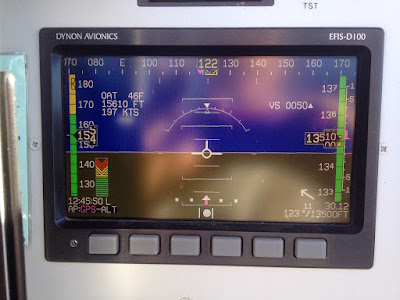
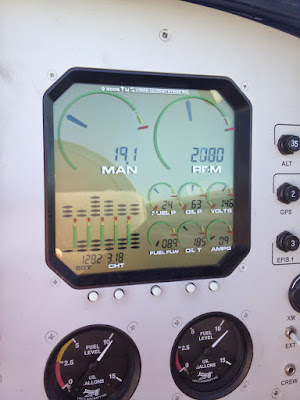
WOT/2200 RPM/11.9K DA/201 KTAS/10.1 GPH
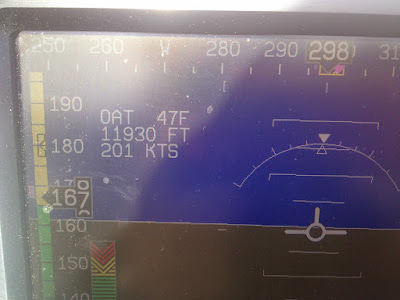
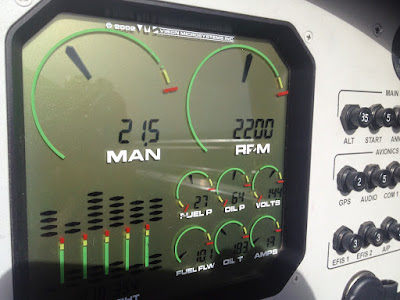
WOT/2300 RPM/13.5K DA/206 KTAS/10.6 GPH
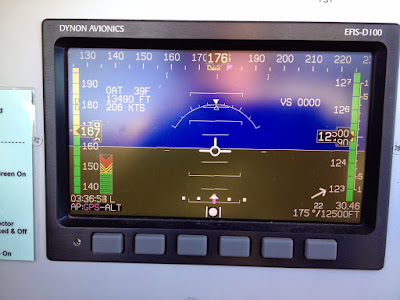
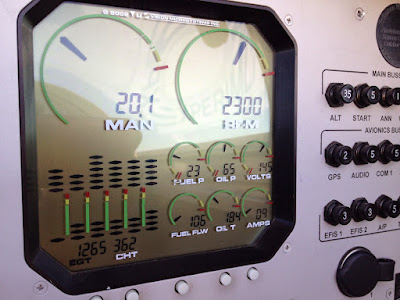
WOT/2500 RPM/12.3K DA/210 KTAS/11.9 GPH (After a fairly hot climb, eng/oil temps higher than normal)
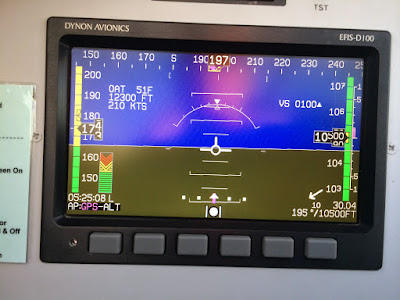
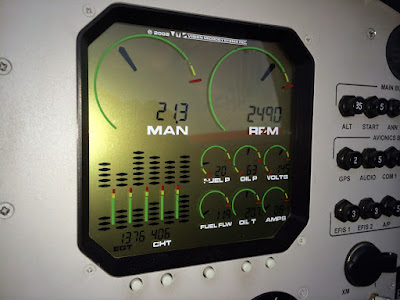
I also liked the "climbing out of a mineshaft" comment Michael!
Is the choice getting easier or more difficult Rob?
Cheers,
Bob
Last edited:
rvmills
Well Known Member
Vern,
I run a Sam James inlet with the standard filter, into a Bendix RSA-5. Updraft sump with elbow duct. For the races this year, I swapped in a DiY straight duct, no filter, which added about 3/4" at speed. It's a strong Lycon motor...very happy with it!
Cold air, forward facing, FM-300 is on the wish list! Before Bill Beaton supercharged his Rocket, he had an inch of MP advantage in a side-by-side test with the 300. (He has a little more than that now...he pulled the same passing trick as Mark did on me at Reno this year too!)
Cheers,
Bob
I run a Sam James inlet with the standard filter, into a Bendix RSA-5. Updraft sump with elbow duct. For the races this year, I swapped in a DiY straight duct, no filter, which added about 3/4" at speed. It's a strong Lycon motor...very happy with it!
Cold air, forward facing, FM-300 is on the wish list! Before Bill Beaton supercharged his Rocket, he had an inch of MP advantage in a side-by-side test with the 300. (He has a little more than that now...he pulled the same passing trick as Mark did on me at Reno this year too!)
Cheers,
Bob
RJLEWISII
Member
Bob (rvmills)
The choice was difficult until yesterday when I received the insurance quote for the HRII, ouch, $2990 vs. $1300 for a like priced RV8. The additional $1700 per year will buy more RV8. I need to fly the Rocket which I'll do when I begin shopping.
Thanks again for all the info/data.
Rob
The choice was difficult until yesterday when I received the insurance quote for the HRII, ouch, $2990 vs. $1300 for a like priced RV8. The additional $1700 per year will buy more RV8. I need to fly the Rocket which I'll do when I begin shopping.
Thanks again for all the info/data.
Rob
Vern may have been giving you a little prod there, Bob. I doubt you can get those MP numbers through an E-0995 cone filter. In fact, they're not very realistic with an unfiltered intake.
Consider your 4th example, 10,500 ft, 210 KTAS, 51F OAT, 2490 RPM. Static pressure is 20.19 Hg. Assuming a 4" diameter intake and 100% VE, intake Q works out to be 0.9 Hg, thus total pressure at the face of the fuel control body is 20.19 + 0.9 = 21.09 Hg. MP is measured at the tail end of one cylinder's intake tract, after the carb loss and tract frictional losses. Carb loss for the RSA-5 alone is roughly 10" H2O, or 0.736 Hg, so 21.09 less 0.736 = 20.35 Hg, best case....but the EIS is reading 21.3. Naa......
Run the same numbers for the RV-8/IO-390 example. We have 7500 ft, 191 KTAS, 52F OAT, and 2420 RPM. It has a 4" intake ring. Assume 100% VE, so intake Q is 0.94. Static is 22.66, so total is 23.6 Hg. I have a filter loss, a carb loss (less than yours, as it's an FM-200), and a tract loss. The end measured MP is 22.5. If the MP sensor is assumed to be accurate, I have a total intake loss of 1.1" Hg between the face of the FM-200 and the MP tap on cylinder #3. I suspect my MP sensor might be a little low. Need to do a static check at annual, which is due now anyway.
The above assumes no separation loss inside the intake. And as always, check my numbers.
Dan
Consider your 4th example, 10,500 ft, 210 KTAS, 51F OAT, 2490 RPM. Static pressure is 20.19 Hg. Assuming a 4" diameter intake and 100% VE, intake Q works out to be 0.9 Hg, thus total pressure at the face of the fuel control body is 20.19 + 0.9 = 21.09 Hg. MP is measured at the tail end of one cylinder's intake tract, after the carb loss and tract frictional losses. Carb loss for the RSA-5 alone is roughly 10" H2O, or 0.736 Hg, so 21.09 less 0.736 = 20.35 Hg, best case....but the EIS is reading 21.3. Naa......
Run the same numbers for the RV-8/IO-390 example. We have 7500 ft, 191 KTAS, 52F OAT, and 2420 RPM. It has a 4" intake ring. Assume 100% VE, so intake Q is 0.94. Static is 22.66, so total is 23.6 Hg. I have a filter loss, a carb loss (less than yours, as it's an FM-200), and a tract loss. The end measured MP is 22.5. If the MP sensor is assumed to be accurate, I have a total intake loss of 1.1" Hg between the face of the FM-200 and the MP tap on cylinder #3. I suspect my MP sensor might be a little low. Need to do a static check at annual, which is due now anyway.
The above assumes no separation loss inside the intake. And as always, check my numbers.
Dan
Kevin Horton
Well Known Member
Considering the effect of the above standard altimeter setting, the fourth example has a pressure altitude of 10,390 ft, and an ambient pressure of 20.67 in HG. 174 kt CAS results in a ram pressure rise of 1.47 in HG. Add the ram pressure rise to the ambient pressure, and we have 21.74 in HG at the entrance to the air inlet, not considering the pressure increase due to the prop (the pressure behind the prop must be somewhat above ambient, but the pressure distribution isn't going to be even across the whole prop area, so I'm not sure how to estimate what it would be at the air inlet).Vern may have been giving you a little prod there, Bob. I doubt you can get those MP numbers through an E-0995 cone filter. In fact, they're not very realistic with an unfiltered intake.
Consider your 4th example, 10,500 ft, 210 KTAS, 51F OAT, 2490 RPM. Static pressure is 20.19 Hg. Assuming a 4" diameter intake and 100% VE, intake Q works out to be 0.9 Hg, thus total pressure at the face of the fuel control body is 20.19 + 0.9 = 21.09 Hg. MP is measured at the tail end of one cylinder's intake tract, after the carb loss and tract frictional losses. Carb loss for the RSA-5 alone is roughly 10" H2O, or 0.736 Hg, so 21.09 less 0.736 = 20.35 Hg, best case....but the EIS is reading 21.3. Naa......
Run the same numbers for the RV-8/IO-390 example. We have 7500 ft, 191 KTAS, 52F OAT, and 2420 RPM. It has a 4" intake ring. Assume 100% VE, so intake Q is 0.94. Static is 22.66, so total is 23.6 Hg. I have a filter loss, a carb loss (less than yours, as it's an FM-200), and a tract loss. The end measured MP is 22.5. If the MP sensor is assumed to be accurate, I have a total intake loss of 1.1" Hg between the face of the FM-200 and the MP tap on cylinder #3. I suspect my MP sensor might be a little low. Need to do a static check at annual, which is due now anyway.
The above assumes no separation loss inside the intake. And as always, check my numbers.
So, Bob's 21.3 in HG MP is somewhat plausible. I know that my RV-8 with Van's standard snorkel air inlet achieves MP above ambient, based on comparing the MP during a full power pass down the runway to the MP seen with engine stopped on the ground. I get about 0.9" above ambient at 185 kt CAS based on the data I've recorded from the engine monitor and EFIS.
vlittle
Well Known Member
Considering the effect of the above standard altimeter setting, the fourth example has a pressure altitude of 10,390 ft, and an ambient pressure of 20.67 in HG. 174 kt CAS results in a ram pressure rise of 1.47 in HG. Add the ram pressure rise to the ambient pressure, and we have 21.74 in HG at the entrance to the air inlet, not considering the pressure increase due to the prop (the pressure behind the prop must be somewhat above ambient, but the pressure distribution isn't going to be even across the whole prop area, so I'm not sure how to estimate what it would be at the air inlet).
So, Bob's 21.3 in HG MP is somewhat plausible. I know that my RV-8 with Van's standard snorkel air inlet achieves MP above ambient, based on comparing the MP during a full power pass down the runway to the MP seen with engine stopped on the ground. I get about 0.9" above ambient at 185 kt CAS based on the data I've recorded from the engine monitor and EFIS.
So the SOP for testing is a full throttle low approach at the local airport? Cool.
rvmills
Well Known Member
Dan, Kevin:
I kept up with Kevin's math a little better than Dan's (but not because it gave me a plausible, versus Dan's improbable?hey, if I'm in a Mythbuster's episode?where's Kari?).
Can you guys refer me to the docs or papers that show the air pressure concepts you are describing. I get the overall idea, but you've piqued my interest in the details!
As far as the numbers in the pics go, I dug back through my iPhone camera roll, to make sure I was putting the correct pictures with each other, and confirmed I did. I know having separate pics of EFIS and EIS could allow questioning the validity or the match-ups, so I wanted to make sure I hadn't bungled that. You may also be saying my MP reading is suspect, so I'd like to know how to best check that too.
Just to peel the onion a little more, here are 4 more samples of WOT/2300 cruise situations. Please work your magic math on what you see, and see if they are plausible. Inquiring minds wanna?well you know!
Two samples from one flight (changing altitude and a pressure drop during flight):
WOT/2300, 14.5K/32F/15.7K DA, 30.27, 201 KTAS, 10.0 GPH, 18.4" MP
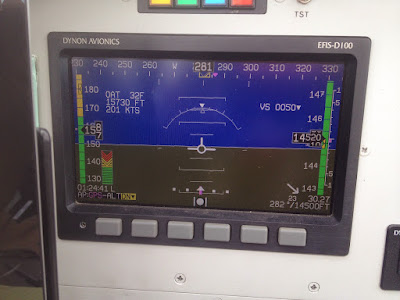
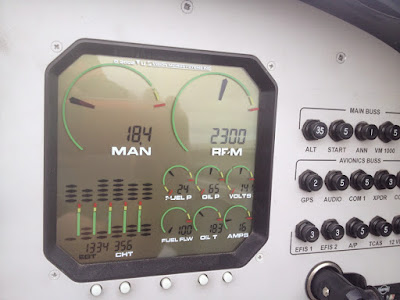
WOT/2300, 12.5K/38F/13.7K DA, 30.16, 203 KTAS, 10.9 GPH, 20.0" MP
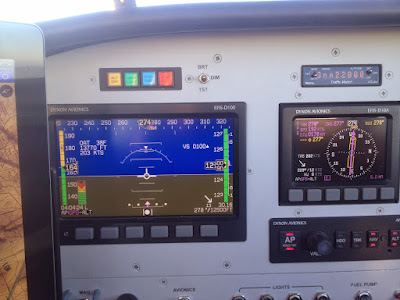
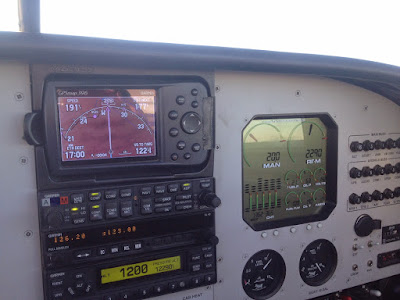
Headed back from Bend, OR and a Lancair Evolution Checkout:
WOT/2300, 11.5K/46F/13.2K DA, 30.03, 205 KTAS, 10.4 GPH, 20.6" MP
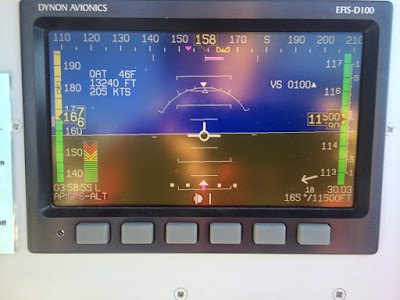
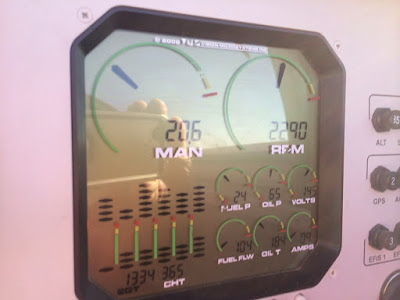
headed home from the Niners game weekend before last:
WOT/2300, 11.5K/29F/11.9K DA, 30.16, 204 KTAS, 10.7 GPH, 20.8 MP
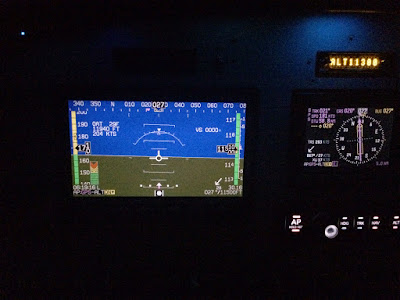
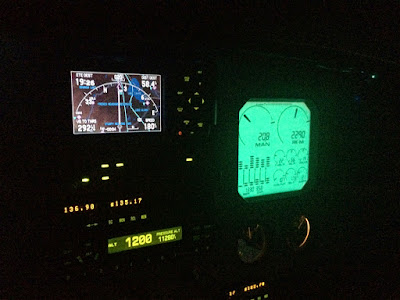
I've always thought I was a bit MP challenged. Guys like Bill Beaton, Mark Frederick, and Greg Nelson have always bested me by an inch or so of MP. I'm always looking for more! I know this is an OT departure from Rob's thread, but its fun to explore. Thanks!
Cheers,
Bob
I kept up with Kevin's math a little better than Dan's (but not because it gave me a plausible, versus Dan's improbable?hey, if I'm in a Mythbuster's episode?where's Kari?).
Can you guys refer me to the docs or papers that show the air pressure concepts you are describing. I get the overall idea, but you've piqued my interest in the details!
As far as the numbers in the pics go, I dug back through my iPhone camera roll, to make sure I was putting the correct pictures with each other, and confirmed I did. I know having separate pics of EFIS and EIS could allow questioning the validity or the match-ups, so I wanted to make sure I hadn't bungled that. You may also be saying my MP reading is suspect, so I'd like to know how to best check that too.
Just to peel the onion a little more, here are 4 more samples of WOT/2300 cruise situations. Please work your magic math on what you see, and see if they are plausible. Inquiring minds wanna?well you know!
Two samples from one flight (changing altitude and a pressure drop during flight):
WOT/2300, 14.5K/32F/15.7K DA, 30.27, 201 KTAS, 10.0 GPH, 18.4" MP


WOT/2300, 12.5K/38F/13.7K DA, 30.16, 203 KTAS, 10.9 GPH, 20.0" MP


Headed back from Bend, OR and a Lancair Evolution Checkout:
WOT/2300, 11.5K/46F/13.2K DA, 30.03, 205 KTAS, 10.4 GPH, 20.6" MP


headed home from the Niners game weekend before last:
WOT/2300, 11.5K/29F/11.9K DA, 30.16, 204 KTAS, 10.7 GPH, 20.8 MP


I've always thought I was a bit MP challenged. Guys like Bill Beaton, Mark Frederick, and Greg Nelson have always bested me by an inch or so of MP. I'm always looking for more! I know this is an OT departure from Rob's thread, but its fun to explore. Thanks!
Cheers,
Bob
Kevin Horton
Well Known Member
So the SOP for testing is a full throttle low approach at the local airport? Cool.
Actually, the 185 kt point was checked at roughly 1000 ft AGL, so I had the same MP that I had seen on the ground a few minutes before with engine stopped. Keeping the MP the same avoided any question of MP indication calibration. The ambient pressure was calculated starting from the pressure altitude.
Considering the effect of the above standard altimeter setting, the fourth example has a pressure altitude of 10,390 ft, and an ambient pressure of 20.67 in HG.
Thanks Kevin, I didn't consider pressure altitude. That aside, can you help me understand your static pressure figure (20.67)? The standard atmosphere references suggest it's a bit high for 10,390 ft.
The difference in dynamic pressure values is because I'm calculating Q for the delta between airbox inlet and outlet velocity. Remember, it's not a dead end pitot. Method later; gotta get to the office.
vlittle
Well Known Member
Actually, the 185 kt point was checked at roughly 1000 ft AGL, so I had the same MP that I had seen on the ground a few minutes before with engine stopped. Keeping the MP the same avoided any question of MP indication calibration. The ambient pressure was calculated starting from the pressure altitude.
OK, that makes sense. Then you use the altimeter to get an accurate indication of the intake boost. That seems to be the gold standard for measuring the efficiency of any induction set-up and sure eliminates arguments.
Kevin Horton
Well Known Member
That's because I made a typo. I should have typed 10,390 ft pressure altitude = 20.267 in HG. Add 1.47 in HG for ram pressure, and you get 21.74.Thanks Kevin, I didn't consider pressure altitude. That aside, can you help me understand your static pressure figure (20.67)? The standard atmosphere references suggest it's a bit high for 10,390 ft.
True, and I hadn't considered the impact on the pressure. That would certainly decrease the potential ram pressure available.The difference in dynamic pressure values is because I'm calculating Q for the delta between airbox inlet and outlet velocity. Remember, it's not a dead end pitot. Method later; gotta get to the office.
I must admit that I have never been able to explain the high MP values I see on my aircraft at high CAS, as they are a bit higher than I can explain with any laws of physics I know. I wonder whether my MP indication (from an EIS 4000) is somehow affected by vibration, or perhaps the bus voltage with engine running being higher than with engine off. I need to pay attention to the MP indication when I throw a battery charger on to see if it moves when the voltage increases.
That's because I made a typo. I should have typed 10,390 ft pressure altitude = 20.267 in HG.
I too am often assaulted by the fickle finger of fart....er, fate
That would certainly decrease the potential ram pressure available.
Here, try this:
[(engine displacement/2)*RPM]/60 = intake volume (engine air demand, in^3/sec)
intake volume/intake area = intake velocity (in/sec)
freestream velocity - intake velocity = velocity for Q calculation
Back to Bob's intake....
10390 PA, 209 KTAS, 51 OAT, 2490 RPM. Static pressure 20.27 Hg. Above calculation assumes 540 ci and 100% VE, so intake volume is 11205 in^3/sec. If Bob has a 4" Sam James ring (12.56 in^2) intake velocity is 892 in/sec, or 44 knots. 209 freestream less - 44 = 165, so intake Q at 10390 and 51 OAT = 0.90 Hg. 20.27 static + 0.9 dynamic = 21.17 Hg total. Assume no filter, and no losses due to separation. RSA-5 carb loss is at least 0.75 Hg at this sort of flow rate (I was at the AFP school this past weekend). 21.17 less 0.75 = 20.42 MP just aft of the throttle plate. The EFIS, with a tap way back at cylinder #5, is showing 21.3.
Last edited:
For Dan and Kevin
Is there any chance that the propellor is acting like a very loose clearance supercharger and providing the mysterious higher than calculated or logical MP values at speed?
It was the 2490 RPM that provided the most questionable MP numbers.
I guess Bob will just need to have his MP sensor calibrated.....
Is there any chance that the propellor is acting like a very loose clearance supercharger and providing the mysterious higher than calculated or logical MP values at speed?
It was the 2490 RPM that provided the most questionable MP numbers.
I guess Bob will just need to have his MP sensor calibrated.....
Last edited:
Kevin Horton
Well Known Member
I did a very quick back of the envelope calculation using the 10,500 ft case in Bob's fourth picture.Is there any chance that the propellor is acting like a very loose clearance supercharger and providing the mysterious higher than calculated or logical MP values at speed?
I don't know the details of his OAT probe location or accuracy, so I assumed that it has an 80% ram recovery factor - i.e. the difference between the indicated OAT and the actual OAT is 80% of the theoretical ram rise from a perfect probe. If he had a perfectly located, laboratory grade OAT probe, with 100% ram rise, the difference between the OAT and the indicated OAT at 210 kt TAS would be 10.5 deg F, i.e. the actual OAT would be 40.5F to give an indicated OAT of 51F. 80% ram recovery gives an actual OAT of 42.6F.
10,500 ft with altimeter setting of 30.04 and an OAT of 42.6 gives a density altitude of 11,700, and a density ratio of 0.7.
I'll assume that Bob's engine can produce 330 hp at sea level on a standard day. Multiply that by 0.7 to get 231 hp available at 11,700 ft density altitude. He was at 2500 rpm instead of 2700 rpm, so let's call it 220 hp.
I'll assume 85% propellor efficiency, giving 187 hp of thrust produced by the prop.
Power = thrust * speed, so thrust = power / speed
Power: 187 hp * 550 ft-lb/s/hp = 102,850 ft-lb/s
Speed: 210 kt TAS = 331.4 ft/s
Power / speed: 102,850 / 331.4 = 310 lb of thrust produced by the prop.
I'll assume an 80" prop diameter, giving a prop disc area of 5027 in^2.
310 / 5027 = 0.0617 psi difference in the average air pressure between the front and back of the prop disc. That converts to 0.126 in HG pressure difference.
Roughly half that pressure difference would the air pressure ahead of the prop being below ambient pressure, and the half would be the air pressure behind the prop being above ambient pressure. Thus the average air pressure behind the whole prop disc would be roughly 0.063 in HG above ambient.
Unless I've screwed up this quick calculation, it seems unlikely that pressure from the prop can explain any more than 0.1 in HG of the MP rise we're seeing.




